
Gaffney is a town in and the seat of Cherokee County, South Carolina, United States, in the Upstate region of South Carolina. Gaffney is known as the "Peach Capital of South Carolina". The population was 12,539 at the 2010 census, with an estimated population of 12,609 in 2019. It is the principal city of the Gaffney, South Carolina, Micropolitan Statistical Area, which includes all of Cherokee County and which is further included in the greater Greenville-Spartanburg-Anderson, South Carolina Combined Statistical Area.
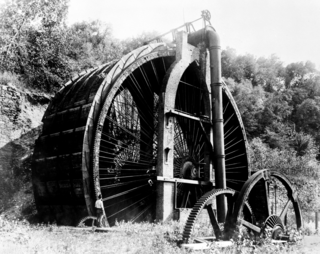
The Burden Iron Works was an iron works and industrial complex on the Hudson River and Wynantskill Creek in Troy, New York. It once housed the Burden Water Wheel, the most powerful vertical water wheel in history. It is widely believed that George Washington Gale Ferris Jr., inventor of the Ferris wheel, had occasion to observe the wheel while a student at Rensselaer Polytechnic Institute. The iron works site was listed on the National Register of Historic Places as an archaeological site in 1977. The Burden Ironworks Office Building was previously listed in 1972.
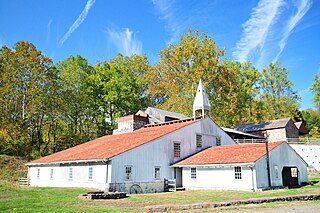
Hopewell Furnace National Historic Site in southeastern Berks County, near Elverson, Pennsylvania, is an example of an American 19th century rural "iron plantation," whose operations were based around a charcoal-fired cold-blast iron blast furnace. The significant restored structures include the furnace group (blast furnace, water wheel, blast machinery, cast house and charcoal house), as well as the ironmaster's house, a company store, the blacksmith's shop, a barn and several worker's houses.

Greenwood Furnace State Park is a 423-acre (171 ha) Pennsylvania state park in Jackson Township, Huntingdon County, Pennsylvania in the United States. The park is near the historic iron making center of Greenwood Furnace. The park includes the ghost town of Greenwood that grew up around the ironworks, old roads and charcoal hearths. Greenwood Furnace State Park is adjacent to Rothrock State Forest and on the western edge of an area of Central Pennsylvania known as the Seven Mountains. The park is on Pennsylvania Route 305, 20 miles (32 km) south of State College.
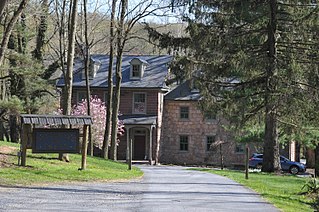
Speedwell Forge Mansion, also known as Speedwell Forge Homestead, is a historic home located at Elizabeth Township, Lancaster County, Pennsylvania. The ironmaster's mansion was built about 1760, and is a 2½-story, four bay wide and two bay deep, brownstone and fieldstone dwelling in the Georgian style. It was expanded about 1795 with a Georgian/Federal style wing. Also on the property are a contributing stone summer kitchen, stone and frame workshop, stone paymaster's office c. 1795), and stone privy.

The Tannehill Ironworks is the central feature of Tannehill Ironworks Historical State Park near the unincorporated town of McCalla in Tuscaloosa County, Alabama. Listed on the National Register of Historic Places as Tannehill Furnace, it was a major supplier of iron for Confederate ordnance. Remains of the old furnaces are located 12 miles (19 km) south of Bessemer off Interstate 59/Interstate 20 near the southern end of the Appalachian Mountains. The 2,063-acre (835 ha) park includes: the John Wesley Hall Grist Mill; the May Plantation Cotton Gin House; and the Iron & Steel Museum of Alabama.

The Katahdin Iron Works is a Maine state historic site located in the unorganized township of the same name. It is the site of an ironworks which operated from 1845 to 1890. In addition to the kilns of the ironworks, the community was served by a railroad and had a 100-room hotel. The site was listed on the National Register of Historic Places in 1969.
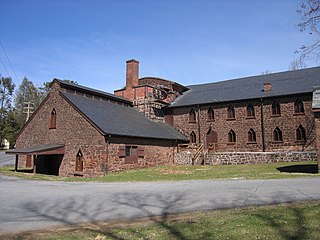
Cornwall Iron Furnace is a designated National Historic Landmark that is administered by the Pennsylvania Historical and Museum Commission in Cornwall, Lebanon County, Pennsylvania in the United States. The furnace was a leading Pennsylvania iron producer from 1742 until it was shut down in 1883. The furnaces, support buildings and surrounding community have been preserved as a historical site and museum, providing a glimpse into Lebanon County's industrial past. The site is the only intact charcoal-burning iron blast furnace in its original plantation in the western hemisphere. Established by Peter Grubb in 1742, Cornwall Furnace was operated during the Revolution by his sons Curtis and Peter Jr. who were major arms providers to George Washington. Robert Coleman acquired Cornwall Furnace after the Revolution and became Pennsylvania's first millionaire. Ownership of the furnace and its surroundings was transferred to the Commonwealth of Pennsylvania in 1932.

Cornwall Furnace is located near Cedar Bluff, Alabama in Cherokee County. It was built by the Noble Brothers to supply iron products to the Confederate States of America during the American Civil War.

Principio Furnace and village is in Cecil County, Maryland, 4 miles (6.4 km) northeast of Havre de Grace, MD.

Washington Iron Furnace is an historic iron furnace, located in Rocky Mount, Franklin County, Virginia. The granite furnace was built around 1770, and measures 30 feet high on its south face. It helped establish industry in the county, and was listed on the National Register of Historic Places in 1973.

The Shelby Iron Company was an iron manufacturing company that operated an ironworks in Shelby, Alabama. The iron company produced iron for the Confederate States of America and was destroyed towards the end of the American Civil War. The company continued to produce iron until the early part of the 20th century.
Coopersville Ironworks Site (38CK2) and Susan Furnace Site (38CK67), also known as the Cherokee Ford Ironworks Site and Nesbitt Iron Manufacturing Co., is a historic archaeological site located near Gaffney, Cherokee County, South Carolina. The site includes the foundations of four large factory buildings, with a system of canal/sluiceways between them, and the remains of three iron furnaces. The outlying furnace, Susan Furnace, includes foundations, sluiceways, slag heaps, and adjacent ore pits. The complex is the largest and best preserved factory complex of any of the 19th century iron manufacturing companies of the region. The complex was developed between 1835 and 1843 by the Nesbitt Iron Manufacturing Company, the largest iron company in South Carolina. The Nesbitt Company was dissolved in the late 1840s, and the Swedish Iron Manufacturing Company of South Carolina operated the ironworks from 1850 until the American Civil War.
Ellen Furnace Site (38CK68) is a historic archaeological site located near Gaffney, Cherokee County, South Carolina. The site includes a partially collapsed but well-preserved iron furnace constructed about 1838 of quarried stone and two earthen sluiceways. Also present are building foundations, tramway road beds, and ore mines. It is directly associated with the nearby Susan Furnace Site. Both were outlying furnace operations associated with the manufacturing complex at Coopersville owned by the Nesbitt Company and later the Swedish Ironworks. The Coopersville Ironworks along with the Susan and Ellen Furnaces were developed between 1835 and 1843 by the Nesbitt Iron Manufacturing Company, the largest iron company in South Carolina. The Nesbitt Company was dissolved in the late 1840s, and the Swedish Iron Manufacturing Company of South Carolina operated the ironworks from 1850 until the American Civil War.
King's Creek Furnace Site (38CK71) is a historic archaeological site located near Kings Creek, Cherokee County, South Carolina, United States. The site contains a partially collapsed but well-preserved iron furnace built about 1838, retaining walls, sluiceway, stone dam abutments, stone building foundations, large piles of slag, and a large slag levee along the creek bank. It also includes the remains of the site's log frame dam. King's Creek Furnace Site is one of two remaining sites that can be associated with the King's Mountain Iron Company, a major iron manufacturing company that operated in present-day Cherokee County from about 1815 to about 1860. The other site is Jackson's Furnace Site in York County.
Nesbitt's Limestone Quarry (38CK69) is a historic archaeological site located near Gaffney, Cherokee County, South Carolina. The site includes the most extensive and best preserved limestone quarry associated with early iron production in the northwestern Piedmont of South Carolina. It was the primary source of limestone for the region's ironworks. Quarrying activity at Nesbitt's ceased in the early part of the 20th century. The site covers approximately 30 acres and has exposed vertical faces of limestone and is located in a large body of limestone that extend in a linear fashion from Limestone College to across the South Carolina state line.
Thicketty Mountain Ore Pits (38CK74) is a historic archaeological site located near Shady Grove Church, Cherokee County, South Carolina. The site includes iron ore pits associated with the South Carolina Manufacturing Company, a major iron manufacturing company that operated in Spartanburg County between about 1825 and about 1850. The iron ore pits or surface mines cover several forested acres along a gently sloping ridge and are generally depressions about two to three meters deep and about five to ten meters across. The pits were last operational in the 1850s.
The Cedar Creek Furnace is a former blast furnace site near Russellville in Franklin County, Alabama. It was the first iron ore furnace in Alabama, preceding an industry that would come to dominate the state's economy in the late 19th and early 20th century.
Clarksville Iron Furnace was a charcoal iron furnace in Unicoi County, Tennessee, built in 1833 and operated until 1844. Its ruins are in Cherokee National Forest and are listed on the National Register of Historic Places.
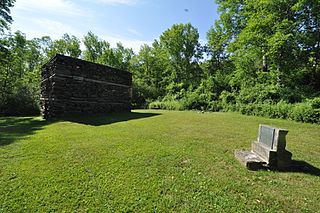
The Mount Riga Ironworks was one of the most successful manufacturers of iron in the late colonial and post-Revolutionary period of United States history. Located in the far northwestern Connecticut town of Salisbury, it produced high quality iron for use in military and domestic applications, and supported a community of 1,200 people. It declined in the mid-19th century, and was closed in 1847. Surviving elements include an early 19th-century cold blast furnace and other foundational and archaeological remains. Its site, now part of a large private holding owned by the Mount Riga Corporation, was listed on the National Register of Historic Places in 1994.















